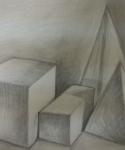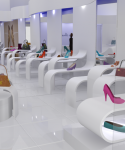|
Facilities |
|||
|
a. Building Area in Sq.Mtrs. |
600 Sq.Mtrs. |
||
|
b. Major Equipment |
Sl. No. |
Name |
Quantity |
|
1. |
LCD Projector. Hitachi CPX450. |
01 |
|
|
2. |
Computer System HCL |
12 |
|
|
3. |
HDV/DV Camcorder with standard accessories.SONY/HVR-VIP. |
01 |
|
|
4. |
LED Television. SONYBravia 117 Cms KDL EX 520. |
01 |
|
|
5. |
Front projection Screen. CRYSTAL Model 8x6. |
01 |
|
|
6. |
Computer Systems .INFINITI M A 380. HCL |
04 |
|
|
7. |
Nikon D 750 body with 24-120mm DSL Camera |
01 |
|
|
8. |
DELL Computer System |
05 |
|
Interior Decoration
Interior Design is defined as “the art or process of designing the interior, often including the exterior, of a room or building". An interior designer is someone who coordinates and manages such projects. Interior design is a multifaceted profession that includes conceptual development, communicating with the stakeholders of a project and the management and execution of the design.
Interior Design Industry has come a long way from a decorative craft which supported the overall architectural scheme into an independent, technology driven, technical course in its own right. The demand for qualified and skilled Assistant Interior Designers is rising gradually with the recent development of Retail Design and Modular Furniture Industry. From a small residential owner to large corporate clients are utilising the services of qualified interior designers. Also due to the awareness created by the mass media including media websites like ‘You Tube’ and Television, the need for qualified Asst. Interior Designers has risen dramatically. The Diploma Program is aimed at fulfilling these needs to produce graduates with an aptitude for innovation, explorative, interdisciplinary and multifaceted knowledge professionals to face the challenges of dynamic industry. In addition to the above the course also provides a platform for students aspiring for higher levels of education including Bachelor of Architecture, Bachelor of Accessory Design (NIFT), and B. Sc. in Interior Design.
Vision
To be distinguished department to enrich a multidisciplinary education by the interaction of arts, science & technology to become competitive and contemporary professionals.
Mission
- To engage students of interior decoration to be responsive to the natural,technological, cultural and social environment through the systematic development of an aesthetic attitude, a technical confidence &critical thinking.
- To provide our students with high ethical values, professional qualities &leadership skills to face any real time challenges.
- To create a platform in interior design for easy adaptation to industry, pursuehigher education and selflearning.
- To provide a strong platform through art and design education to produce a competent candidate in par with other technical programs.
|
PEO - 1 |
Analyze, Design and solve problems related to interior Decoration and adopt to new innovative construction technology by selflearning. |
|
PEO - 2 |
To carry out the work efficiently with sincerity and dedication as individuals and in a team, exhibiting leadership Qualities to meet the goals of a project or a organization. |
|
PEO - 3 |
Work with expertise and engage students in higher learning leading to degrees or certifications. |
Programme Outcomes (POs)
|
PO - 1 |
Basic and Discipline specific knowledge: Apply knowledge of basic mathematics, science and engineering fundamentals and engineering specialization to solve the engineering problems. |
|
PO - 2 |
Problem analysis: Identify and analyse well-defined engineering problems using codified standard methods. |
|
PO - 3 |
Design/ development of solutions: Design solutions for well-defined technical problems and assist with the design of systems components or processes to meet specified needs. |
|
PO - 4 |
Engineering Tools, Experimentation and Testing: Apply modern engineering tools and appropriate technique to conduct standard tests and measurements. |
|
PO - 5 |
Engineering practices for society, sustainability and environment: Apply appropriate technology in context of society, sustainability, environment and ethical practices. |
|
PO - 6 |
Project Management: Use engineering management principles individually, as a team member or a leader to manage projects and effectively communicate about well-defined engineering activities. |
|
PO - 7 |
Life-long learning: Ability to analyse individual needs and engage in updating in the context of technological changes. |













